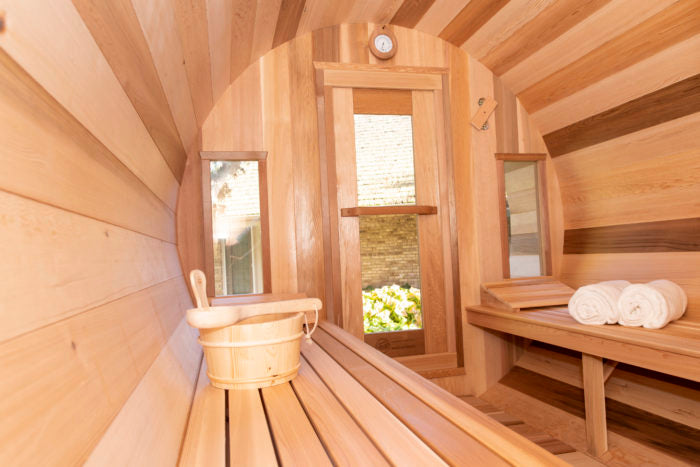The 45-Second Trick For Traditional Sauna
The 45-Second Trick For Traditional Sauna
Blog Article
Not known Factual Statements About Traditional Sauna
Table of ContentsThe 6-Minute Rule for Traditional SaunaThe Only Guide for Traditional SaunaThe 2-Minute Rule for Traditional SaunaNot known Facts About Traditional SaunaThe smart Trick of Traditional Sauna That Nobody is Discussing
Most of the weight lost in a sauna is water loss and is re-gained upon rehydrating. Nonetheless, without an uncertainty sauna can be a fundamental part of a healthy fat burning program. To consider the distinctions in between typical and IR saunas, I will certainly divide these into verifiable, theoretical, and produced distinctions.Hence, the best factor in the saunawhich goes to the ceiling directly over the sauna heateris commonly between 185 and 190 F. Claims that a conventional sauna goes beyond 200 F is merely not true and not suitable for electrical saunas offered in the US. The temperature level for a far-infrared sauna is usually set between 120 and 140 F; nonetheless, unlike the traditional sauna, the goal in and IR space is not to achieve a heat.

When a standard sauna has been appropriately heated up, the sauna walls are cozy, the air temperature level has actually accomplished established temperature level and the rocks are super heated. As a fascinating side note, the heated wall surfaces and the rocks are discharging far-infrared warm, combined with the warmed air, to produce an "wrapping up warm".
Traditional Sauna - Questions
When the heat is attained, the components cycle on and off to maintain the heat. The majority of standard sauna individuals enjoy putting water over the rocks to develop vapor to increase sauna moisture levels. The benefits of putting water over the rocks include: making the space much more comfortable, dampening the nasal passages, and enabling the usage of aromatherapy by blending essential oils with the water.

When the energy gets in the body, it creates the body temperature to boost and inevitably causes sweating. In an infrared sauna it is essential for the emitters/heaters to continue to be on almost regularly. Because there is no mass of rocks to preserve heat, the sauna will cool down if the emitters shut down.
A Biased View of Traditional Sauna
As mentioned above, the sauna bather in an infrared space wishes to place himself in front of operating emitters to obtain optimal gain from the heat. The heating time for the two areas can be really various, depending upon how the rooms are utilized. For a standard sauna, a bather must allow 30-40 mins for the space to accomplish a desired temperature and to effectively pre-heat the rocks.

A well constructed sauna will typically accomplish a temperature of 150-160 F in about 30-40 minutes (Traditional Sauna). For hotter temperatures, the room might require to heat for a longer duration. As soon as the room accomplishes set temperature, the heater will certainly cycle on and off, usually operating about 50% of the time. The insulated wall surfaces and the warmed rocks will keep the area warm and at stable temperature levels.
To some, 15 mins was "lost" while the infrared power warmed the wood panels as opposed to heating up a body, while others find a pre-heated room to be a lot more comfy and think a raised starting temperature is needed to begin perspiring. The size Resources of recommended usage for every space is approximately the exact same (10-15 minutes per session); however, because of the lower air temperature levels and the capacity to feel the effects of infrared warmth faster than a typical sauna, it is not uncommon for a person to spend a total of 20-30 minutes in an infrared sauna.
The Best Strategy To Use For Traditional Sauna

The typical expense per kWH of electrical power in the united state is around $0.11, so a 4.5 kW heating system will certainly cost about $.50 to run for one hour, if the heater runs continually for one hour. Typically a sauna heating unit will certainly compete 75% of the first hour and 50% of succeeding hours on because the components cycle once the established temperature is achieved.
A two person far-infrared space is normally physically smaller than a traditional sauna, typically about 4' x 4' or smaller. The IR furnace is typically 1.5-1.7 kW making use of a 120 volt 15 amp plug-in solution. Given that the room can be made use of sooner than a sauna room, we will presume the area is utilized for to of an hour consisting of warmth up time.
Finally, there is a rarely reviewed distinction in the social experience between both spaces. While our culture has actually shed some of the social advantage of the typical sauna experience, it can be extremely socially satisfying (Traditional Sauna). From household time in the sauna, to heart-felt discussions with considerable others, to sauna partiesthe standard sauna experience can cause intimate socializing
Not known Details About Traditional Sauna
Most greater end infrared areas include colored light treatment, stereo and full-glass fronts. The dimension of the majority of areas enable 2 people to easily use the room, while some styles may allow for a 3rd or fourth person to find more use the space. Custom-made infrared spaces are likewise readily available, with area sizes offered approximately 7' x 8' x 7' high.
Report this page